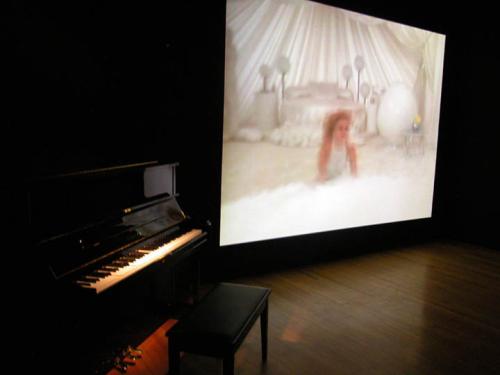Jonathan Horowitz
dal 25/6/2004 al 11/9/2004
Segnalato da
25/6/2004
Jonathan Horowitz
Galerie Barbara Weiss (old location), Berlin
The video installation Silent Movie brings together excerpts from four American movie classics, showing parallel narratives: Johnny Belinda, 1948; The Story of Esther Costello, 1957; The Miracle Worker, 1962 and The Who's Rock Opera Tommy, 1975. The films each feature a central deaf-mute character, who is ostensibly liberated from his/her physical condition through acquisition of language. Horowitz especially pays attention to the scenes dealing with violence, power, sex and silence.

Jonathan Horowitz
Silent Movie is the central work in the exhibition of the American artist Jonathan Horowitz (born 1966 in New York City) that is shown at Galerie Barbara Weiss.
The video installation Silent Movie brings together excerpts from four American movie classics, showing parallel narratives: Johnny Belinda, 1948; The Story of Esther Costello, 1957; The Miracle Worker, 1962 and The Who's Rock Opera Tommy, 1975. The films each feature a central deaf-mute character, who is ostensibly liberated from his/her physical condition through acquisition of language. Horowitz especially pays attention to the scenes dealing with violence, power, sex and silence.
The Miracle Worker tells the story of the deaf-mute and blind Helen Keller and her teacher Annie Sullivan. By learning sign language Keller is transformed from a violent and defenceless child with no relation to her environment into a well-educated young woman.
In Johnny Belinda a deaf and speech-impaired girl is raped and subsequently murders her attacker. Forced to stand trial, Belinda uses sign language to speak in her own defense. In this complex story about victimization and dependency, Belinda manages to get over physical, emotional and even legal obstacles.
The fictional stories of Tommy and Esther Costello provide the central narrative action in Silent Movie. Rendered blind, deaf and mute they grow up in an environment of confusion an abuse. Despite these similarities, Tommy and Esther Costello present two dramatically different stories of liberation of disability and recovery of senses. By juxtaposing and displacing scenes from The Story of Esther Costello and Tommy with moments from The Miracle Worker and Johnny Belinda, Horowitz forces these films into a new relationship.
With the accompanying piano sounds from Tommy, Horowitz generates a figurative relation to the era of silent film. Like the brief lines of descriptive or exclamatory text in silent films, the musical score of Silent Movie establishes mood and provides the audience with interpretive cues. Thus, the score of Silent Movie, although devoid of lyrics, can be seen as a metaphor for language, conveying the words and emotions of characters unable to be heard. Horowitz manages to achieve a singular cinematic experience oscillating between unability of communication and an overload of massmedial imagery and information, and which is reinforced by the experiential darkness of the black gallery space.
Horowitz's interest in language, silence and self-expression are reinforced in a series of digitally rendered prints showing actors and other celebrities – i.e. Helen Keller and Charlie Chaplin. These works explicate the themes in Silent Movie but also function independently. According to Horowitz, the prints also serve to 'politicize the idea of silence', depicting individuals for whom self-expression is intimately related to silence.
The influence of popular television and film is an ongoing concern in Jonathan Horowitz's work. In recent years his projects have explored everything from television sitcoms to film, examining the role these media play in the construction of personal and collective identity.
Current exhibitions of the artist:
The Ten Commandments, Deutsches Hygiene Museum, Dresden; Museum of Modern Art, Frankfurt am Main
Marilyn, Gallery Sean Kelly, New York; The Future has a Silver Lining. Genealogies of Glamour, Migros Museum Zürich, Switzerland; A Fripon, Fripon et Demi – A School for Truants, Collection Lambert, Avignon; Let the Bullshit Run a Marathon, Nicole Klagsbrun, New York
Opening: 26 June, 7–9pm
26 June until 11 September 2004
Opening hours: Tuesday to Saturday, 11am–6pm
(August: by appointment)
Image: Silent Movie Installation view, Wadsworth Atheneum Museum of Art, Hartford,CT
Galerie Barbara Weiss - Zimmerstrasse 88-89 10117 Berlin



